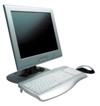 IT Equipment Use - Workplace:
IT Equipment Use - Workplace:
•
ICT Infrastructure & Statistics In
Gambia the rate of use of computers into workplaces
is very high; 66.2% of institutions on the average owned
/ accessed more than one computer whilst 12.0% owned
only one PC. In
Gambia the rate of use of computers into workplaces
is very high; 66.2% of institutions on the average owned
/ accessed more than one computer whilst 12.0% owned
only one PC.
Photocopying machines are normally found and used in
most workplaces, on average about 45.8% institutions
used photocopying machines but some local government
areas reported low usage of copying machines in the
workplaces in Mansakonko (11.2%), Kerewan (17.1%) and
Janjangbureh (12.5%).
 Nationally, the overall availability and usage of other
information and communications technology equipments
like fax machine and printers in offices is quite high
at a rate of 38.5% and 58.7% respectively. The rate
of penetration of digital projectors is very low in
the offices.
Nationally, the overall availability and usage of other
information and communications technology equipments
like fax machine and printers in offices is quite high
at a rate of 38.5% and 58.7% respectively. The rate
of penetration of digital projectors is very low in
the offices.
 Public Key Infrastructure:
Public Key Infrastructure:
The development of a legislative and regulatory framework
for the use of information technology in a secured environment
is limited.
 Communication Links:
Communication Links:
There is only one public television station and no private
television station in the Gambia but satellite and cable
viewing is possible. There are also one public radio,
five private radio and three community radio stations.
 Projects for Development:
Projects for Development:
A number of projects have being designed and implemented
by government and public institutions to enhance accessibility
and use of IT equipments and services in the country.
 Equipment Used, IT Services - Households:
Equipment Used, IT Services - Households:
 Households
mainly obtain information through the use of radio,
mobile telephone and television programmes for increased
productivity and growth. At national level about 90%
of households have radios, 40% have a television and
56% use mobile telephone to send and receive information. Households
mainly obtain information through the use of radio,
mobile telephone and television programmes for increased
productivity and growth. At national level about 90%
of households have radios, 40% have a television and
56% use mobile telephone to send and receive information.
 Other
information technology equipments and facilities are
found in both urban and rural households. The survey
results showed that about 2% of individuals in households
used computers in the last 12 months whilst only 1%
of individuals in households have internet facilities
in the same period. Other
information technology equipments and facilities are
found in both urban and rural households. The survey
results showed that about 2% of individuals in households
used computers in the last 12 months whilst only 1%
of individuals in households have internet facilities
in the same period.

 Internet Access:
Internet Access:
 The Gambia was the first country to participate in the
UNDP's Internet Initiative for Africa programme to assist
in creating a low-cost Internet backbone running at
512Kbps via Teleglobe in Canada, with local high speed
POPs to provide national coverage.
The Gambia was the first country to participate in the
UNDP's Internet Initiative for Africa programme to assist
in creating a low-cost Internet backbone running at
512Kbps via Teleglobe in Canada, with local high speed
POPs to provide national coverage.
 The
first ISP connected to the system was QuantumNet. Online
services that are commonly used in the by people are
email, web browsing, web hosting, discussion forum and
file transfers. Four Internet Service Providers (ISP);
Gamtel, QuantumNet and Netpage are licensed to operate
and to provide dial-up internet access to the public
and to institutions. The technology services provided
through dial-up system are cheaper in the Gambia than
in many African countries. The
first ISP connected to the system was QuantumNet. Online
services that are commonly used in the by people are
email, web browsing, web hosting, discussion forum and
file transfers. Four Internet Service Providers (ISP);
Gamtel, QuantumNet and Netpage are licensed to operate
and to provide dial-up internet access to the public
and to institutions. The technology services provided
through dial-up system are cheaper in the Gambia than
in many African countries.
 With
regard to internet connectivity, the survey results
revealed that on the average 46.2% of institutions covered
have had internet connectivity whilst 22.1% of the workplaces
interviewed have their own websites. With
regard to internet connectivity, the survey results
revealed that on the average 46.2% of institutions covered
have had internet connectivity whilst 22.1% of the workplaces
interviewed have their own websites.

 Training in the Use of ICT:
Training in the Use of ICT:
Status of ICT in Education sector:-
 The
importance of information technology underscores the
importance of adopting IT in schools. The availability
of computers in the education sector is still very low,
on the average and at national level; student-to-computer
ratio is 142 students per PC. The availability of computers
to pupils increases with increase in the level of education.
In fact, 256 students in Lower Basic School have to
share one PC whereas 10 pupils in tertiary / higher
education share a computer. In the urban areas, there
are about 29 students per PC in the Senior Secondary
schools whilst there are only 11 pupils per computer
in the Vocational schools. The
importance of information technology underscores the
importance of adopting IT in schools. The availability
of computers in the education sector is still very low,
on the average and at national level; student-to-computer
ratio is 142 students per PC. The availability of computers
to pupils increases with increase in the level of education.
In fact, 256 students in Lower Basic School have to
share one PC whereas 10 pupils in tertiary / higher
education share a computer. In the urban areas, there
are about 29 students per PC in the Senior Secondary
schools whilst there are only 11 pupils per computer
in the Vocational schools.
 With
regard to training received in the use of the IT, there
are disparities according to gender. Our survey results
shows that there are only 18 percent of the female students
enrolled in tertiary education who are in an ICT dominated
field whiles there are about 60 percent of the male
pupils in the same category who are in an IT dominated
field. However, the results concern with Vocational/Technical
schools show a higher participation of female in ICT
field than the males. There were 17 percent of female
student in this school category who are in an IT dominated
field as against only 15 percent of male pupils in the
same school category are in an ICT dominate field. With
regard to training received in the use of the IT, there
are disparities according to gender. Our survey results
shows that there are only 18 percent of the female students
enrolled in tertiary education who are in an ICT dominated
field whiles there are about 60 percent of the male
pupils in the same category who are in an IT dominated
field. However, the results concern with Vocational/Technical
schools show a higher participation of female in ICT
field than the males. There were 17 percent of female
student in this school category who are in an IT dominated
field as against only 15 percent of male pupils in the
same school category are in an ICT dominate field.
The proportion of students and teachers using the internet
is very high. About 98.4% of pupils and 98.9% of teachers
used the world wide web for email messaging.
 Limitations to Access to IT:
Limitations to Access to IT:
•
Education-low literacy levels
 To develop the economy and improve the lives of local
people we therefore need a basic level of education
underpinned by developing a learning culture. The ability
to use new technology that is ever changing, acquire
relevant knowledge and convey information in a manner
that empowers individuals to maximize their natural
potential perhaps stands out as the most basic prerequisite.
In this regard, opportunities to use ICTS has to be
precluded by training and learning.
To develop the economy and improve the lives of local
people we therefore need a basic level of education
underpinned by developing a learning culture. The ability
to use new technology that is ever changing, acquire
relevant knowledge and convey information in a manner
that empowers individuals to maximize their natural
potential perhaps stands out as the most basic prerequisite.
In this regard, opportunities to use ICTS has to be
precluded by training and learning.
•
Low Skilled Workforce
The proliferation of IT training will provide a future
base but now it is important we recognize that the relevant
knowledge base and therefore skills required to be competitive
or have the competitive edge are lacking. Before we
even get in to the IT fields or the lack of it in schools,
what first comes to mind is the ongoing debate about
the atrocious level of English proficiency in schools.
Language forms a fundamental part of development and
it is through this that the principle of skill acquisition
is based on regardless of which skill one needs to acquire.
• Awareness & Sensitization
“Information is power” to empower and power to act.
The completely learning process for us in Africa and
The Gambia specifically, is challenged by how quickly
we raise the level of awareness of ICTs. At present,
the information technology industry in is focusing
more on selling PCs, basic computer training, networking
and a few other basic services. The innovation to demonstrate
to people what a simple computer program can do for
them or their business that can translate to the need
for PCs is lacking.
• Affordability
of Equipment & Services
 Universal
usage to and affordability of are inextricably linked.
The cost of computers and the price of accessing the
World Wide Web are one of the main issues that influence
the spread of ICTs. Purchase of equipment is still far
beyond the reach of the average citizen. The high price
tags compared to other necessities in life act as a
barrier to getting to use ICT equipments and services. Universal
usage to and affordability of are inextricably linked.
The cost of computers and the price of accessing the
World Wide Web are one of the main issues that influence
the spread of ICTs. Purchase of equipment is still far
beyond the reach of the average citizen. The high price
tags compared to other necessities in life act as a
barrier to getting to use ICT equipments and services.
• Gender Differences
The high cost of PCs and connectivity keep IT services
far beyond the reach of most women. The infrastructure
is largely urban-centred. Internet content is overwhelmingly
in English. Insufficient attention is given to content
in local languages and the use of the Internet for women
with low levels of literacy. Gender roles and other
cultural factors translates to the fact that women have
less time to make use of the latest equipment. |